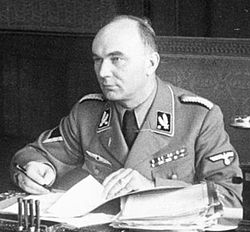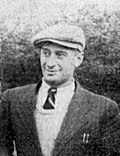Chełmno extermination camp
Chełmno extermination camp (German: [Vernichtungslager Kulmhof] Error: {{Lang}}: text has italic markup (help)) was the first extermination camp (death camp) opened by Nazi Germany. It was 50 kilometres (31 mi) north of the city of Łódź, Poland. In 1939, Nazi Germany had invaded Poland, and had annexed (took control of) parts of Poland.
The Nazis built Chełmno with the specific goal of carrying out ethnic cleansing through mass murder. The Nazis kept Chełmno open from December 8, 1941, as part of Operation Reinhard during the most deadly phase of the Holocaust, and again from June 23, 1944 to January 18, 1945 during the Soviet counter-offensive.
The Nazis murdered over 150,000 people at Chełmno,[1] including many Polish Jews from the Łódź Ghetto and the local people who lived in Reichsgau Wartheland (Warthegau).[2]
Victims

The Nazis killed at least 152,000 people at Chełmno.[1] Nazi officials were eventually charged with killing at least 180,000 victims.[4]
The Kulmhof Museum of Martyrdom (pl)says that around 200,000 people were killed at Chełmno.[5]
Most of the people killed at Chełmno were:
- Jews from west-central Poland;[2]
- Roma people from around Poland;
- Soviet prisoners of war; or
- Jews who had been forced to live in the Łódź Ghetto. These included Jews from Hungary, Bohemia, Moravia, Germany, Luxemburg, and Austria.
The Nazis killed these victims using gas vans. They forced the victims into large vans, and then pumped carbon monoxide into the vans to suffocate and kill the victims.[1]
Early on, the Nazis experimented at Chełmno. They developed methods which they used later during The Holocaust in Nazi-controlled Poland.[6]
Destruction
Russian soldiers captured the town of Chełmno on January 17, 1945. By then, the Nazis had already destroyed evidence that the Chełmno camp ever existed. They left no prisoners behind.[7] One of the camp's survivors, who was fifteen years old at the time, said that only three Jewish males had escaped successfully from Chełmno.[8]
In 1961, the three best-known survivors testified about Chełmno at Adolf Eichmann's trial in Jerusalem. In 1962-1965, two survivors also testified at trials held in West Germany against people who worked at the camp.[8]
Chełmno Extermination Camp Media
Gauleiter Arthur Greiser in Poznań (Posen), 1939
Jews were delivered by train to Koło, then to nearby Powiercie, and in overcrowded lorries to the camp. They were forced to abandon their bundles along the way. In this photo, loading of victims sent from the Łódź Ghetto.
Michał Podchlebnik in 1945
Szymon Srebrnik during the Eichmann trial
References
- ↑ 1.0 1.1 1.2 USHMM (May 11, 2012). "Chelmno" (permission granted to be reused, in whole or in part, on Wikipedia; OTRS ticket no. 2007071910012533 confirmed). Holocaust Encyclopedia. United States Holocaust Memorial Museum, Washington, DC. Retrieved May 12, 2013.
Text from USHMM has been released under the GFDL. The website can offer no guarantee that the information is correct in each circumstance.
- ↑ 2.0 2.1 Main Commission for Investigation of German Crimes in Poland, German Crimes in Poland (Warsaw: 1946, 1947) Archived 2011-06-28 at the Wayback Machine, Archive of Jewish Gombin Genealogy, with introduction by Leon Zamosc. Note: The Main (or Central) Commission for Investigation of German Crimes in Poland (Polish: [Główna Komisja Badania Zbrodni Niemieckich w Polsce, GKBZNwP] Error: {{Lang}}: text has italic markup (help)) founded in 1945 was the predecessor of the Institute of National Remembrance (see also the "Main Commission". Archived from the original on February 12, 1997. Retrieved May 25, 2017.
{{cite web}}: CS1 maint: bot: original URL status unknown (link)). Quote: "The Main Commission for the Investigation of Crimes Against the Polish Nation - The Institute of National Memory... has a fifty years long history (1995). The creation of the Main Commission... was preceded by work done in London since 1943 by the Polish Government in Exile." - ↑ "SS use of mobile gassing vans". A damaged Magirus-Deutz van found in 1945 in Kolno, Poland. World War II Today. 2011. Retrieved April 21, 2013.
Source: Office of the United States Chief Counsel for Prosecution of Axis Criminality: Nazi Conspiracy and Aggression – Washington, U.S Govt. Print. Office, 1946, Vol III, p. 418.
- ↑ JTA (January 22, 1963). "Jewish Survivors of Chelmno Camp Testify at Trial of Guards". JTA Archive. Jewish Telegraphic Agency. Archived from the original on 2014-02-20. Retrieved 2013-05-17.
- ↑ Kulmhof 1941-1945. The German Death Camp in Chełmno on the Ner, Chełmno Muzeum of Martyrdom, Poland (Muzeum byłego niemieckiego Obozu Zagłady Kulmhof w Chełmnie nad Nerem), 2015, archived from the original on 2014-03-09
- ↑ A secret memorandum of June 5, 1942 written by one Willy Just, to the Director of section II D SS-Obersturmbannführer Walter Rauff at the Reich Main Security Office (Reichssicherheitshauptamt in Berlin), contained five pages of numbered paragraphs, suggesting mechanical improvements to gas vans. In the opening line, the letter stated: "ninety-seven thousand have been processed, using three vans, without any defects showing up in the vehicles" (see attached photocopies at HolocaustHistory.org) Archived 2015-05-21 at the Wayback Machine In his postwar testimony Obersturmbannführer August Becker, the gas van inspector, claimed that the letter was sent by himself on June 5, 1942 to Walter Rauff in RSHA. See: Klee, Ernst; Dressen, Willi; Riess, Volker (1991). The gas-vans: A new and better method of killing had to be found. The Good Old Days: The Holocaust As Seen by Its Perpetrators and Bystanders. Konecky Konecky. pp. 69–70. ISBN 978-1-56852-133-6. Retrieved June 29, 2015. Nevertheless, Christopher Browning confirmed in his "Evidence for the Implementation of the Final Solution". Archived from the original on 2012-08-12. (2000) that the letter was sent by Just, not by Becker, as shown through the archives of RSHA: Just an Rauff, 5.6.42; BA, R 58/871.
- ↑ Alpha History textbook; resource centre. "Liberation of the camps". Resources. Australia, New Zealand, United States, Canada, Great Britain: Alpha History. Retrieved 30 June 2015.[dead link]
- ↑ 8.0 8.1 Lefkovits, Etgar (September 18, 2006). "The last survivor". The Jerusalem Post. Archived from the original on July 13, 2011. Retrieved February 11, 2011.







